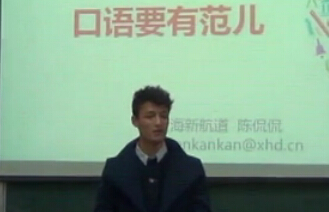雅思阅读真题之Sun's fickle heart may leave us cold
2013-08-01 11:30 供稿单位: 新航道
出国英语考试有哪些 雅思6.5是什么水平 雅思阅读评分标准 托福阅读评分标准 雅思和托福的区别
Sun's fickle heart may leave us cold
1 There's a dimmer switch inside the sun that causes its brightness to rise and fall on timescales of around 100,000 years - exactly the same period as between ice ages on Earth. So says a physicist who has created a computer model of our star's core.
2 Robert Ehrlich of George Mason University in Fairfax, Virginia, modelled the effect of temperature fluctuations in the sun's interior. According to the standard view, the temperature of the sun's core is held constant by the opposing pressures of gravity and nuclear fusion. However, Ehrlich believed that slight variations should be possible.
3 He took as his starting point the work of Attila Grandpierre of the Konkoly Observatory of the Hungarian Academy of Sciences. In 2005, Grandpierre and a collaborator, Gábor ágoston, calculated that magnetic fields in the sun's core could produce small instabilities in the solar plasma. These instabilities would induce localised oscillations in temperature.
4 Ehrlich's model shows that whilst most of these oscillations cancel each other out, some reinforce one another and become long-lived temperature variations. The favoured frequencies allow the sun's core temperature to oscillate around its average temperature of 13.6 million kelvin in cycles lasting either 100,000 or 41,000 years. Ehrlich says that random interactions within the sun's magnetic field could flip the fluctuations from one cycle length to the other.
5 These two timescales are instantly recognisable to anyone familiar with Earth's ice ages: for the past million years, ice ages have occurred roughly every 100,000 years. Before that, they occurred roughly every 41,000 years.
6 Most scientists believe that the ice ages are the result of subtle changes in Earth's orbit, known as the Milankovitch cycles. One such cycle describes the way Earth's orbit gradually changes shape from a circle to a slight ellipse and back again roughly every 100,000 years. The theory says this alters the amount of solar radiation that Earth receives, triggering the ice ages. However, a persistent problem with this theory has been its inability to explain why the ice ages changed frequency a million years ago.
7 "In Milankovitch, there is certainly no good idea why the frequency should change from one to another," says Neil Edwards, a climatologist at the Open University in Milton Keynes, UK. Nor is the transition problem the only one the Milankovitch theory faces. Ehrlich and other critics claim that the temperature variations caused by Milankovitch cycles are simply not big enough to drive ice ages.
8 However, Edwards believes the small changes in solar heating produced by Milankovitch cycles are then amplified by feedback mechanisms on Earth. For example, if sea ice begins to form because of a slight cooling, carbon dioxide that would otherwise have found its way into the atmosphere as part of the carbon cycle is locked into the ice. That weakens the greenhouse effect and Earth grows even colder.
9 According to Edwards, there is no lack of such mechanisms. "If you add their effects together, there is more than enough feedback to make Milankovitch work," he says. "The problem now is identifying which mechanisms are at work." This is why scientists like Edwards are not yet ready to give up on the current theory. "Milankovitch cycles give us ice ages roughly when we observe them to happen. We can calculate where we are in the cycle and compare it with observation," he says. "I can't see any way of testing [Ehrlich's] idea to see where we are in the temperature oscillation."
10 Ehrlich concedes this. "If there is a way to test this theory on the sun, I can't think of one that is practical," he says. That's because variation over 41,000 to 100,000 years is too gradual to be observed. However, there may be a way to test it in other stars: red dwarfs. Their cores are much smaller than that of the sun, and so Ehrlich believes that the oscillation periods could be short enough to be observed. He has yet to calculate the precise period or the extent of variation in brightness to be expected.
11 Nigel Weiss, a solar physicist at the University of Cambridge, is far from convinced. He describes Ehrlich's claims as "utterly implausible". Ehrlich counters that Weiss's opinion is based on the standard solar model, which fails to take into account the magnetic instabilities that cause the temperature fluctuations.
(716 words)
副标题#e#
Questions 1-4 Complete each of the following statements with One or Two names of the scientists from the box below.
Write the appropriate letters A-E in boxes 1-4 on your answer sheet.
A. Attila Grandpierre
B. Gábor ágoston
C. Neil Edwards
D. Nigel Weiss
E. Robert Ehrlich
1. ...claims there抯 a dimmer switch inside the sun that causes its brightness to rise and fall in periods as long as those between ice ages on Earth.
2. ...calculated that the internal solar magnetic fields could produce instabilities in the solar plasma.
3. ...holds that Milankovitch cycles can induce changes in solar heating on Earth and the changes are amplified on Earth.
4. ...doesn't believe in Ehrlich's viewpoints at all.
Questions 5-9 Do the following statements agree with the information given in the reading passage?
In boxes 5-9 on your answer sheet write
TRUE if the statement is true according to the passage
FALSE if the statement is false according to the passage
NOT GIVEN if the information is not given in the passage
5. The ice ages changed frequency from 100,000 to 41,000 years a million years ago.
6. The sole problem that the Milankovitch theory can not solve is to explain why the ice age frequency should shift from one to another.
7. Carbon dioxide can be locked artificially into sea ice to eliminate the greenhouse effect.
8. Some scientists are not ready to give up the Milankovitch theory though they haven't figured out which mechanisms amplify the changes in solar heating.
9. Both Edwards and Ehrlich believe that there is no practical way to test when the solar temperature oscillation begins and when ends.
Questions 10-14 Complete the notes below.
Choose one suitable word from the Reading Passage above for each answer.
Write your answers in boxes 10-14 on your answer sheet.
The standard view assumes that the opposing pressures of gravity and nuclear fusions hold the temperature ...10...in the sun's interior, but the slight changes in the earth's ...11... alter the temperature on the earth and cause ice ages every 100,000 years. A British scientist, however, challenges this view by claiming that the internal solar magnetic ...12... can induce the temperature oscillations in the sun's interior. The sun's core temperature oscillates around its average temperature in ...13... lasting either 100,000 or 41,000 years. And the ...14... interactions within the sun's magnetic field could flip the fluctuations from one cycle length to the other, which explains why the ice ages changed frequency a million years ago.
副标题#e#
Answer keys and explanations:
1. E
See the sentences in paragraph 1(There's a dimmer switch inside the sun that causes its brightness to rise and fall on timescales of around 100,000 years - exactly the same period as between ice ages on Earth. So says a physicist who has created a computer model of our star's core.) and para.2 (Robert Ehrlich of George Mason University in Fairfax, Virginia, modelled the effect of temperature fluctuations in the sun's interior.)
2. A B
See para.3: ?i style='mso-bidi-font-style: normal'>Grandpierre and a collaborator, Gábor ágoston, calculated that magnetic fields in the sun's core could produce small instabilities in the solar plasma.
3. C
See para.8: Edwards believes the small changes in solar heating produced by Milankovitch cycles are then amplified by feedback mechanisms on Earth.
4. D
See para.11: Nigel Weiss, a solar physicist at the University of Cambridge, is far from convinced. He describes Ehrlich's claims as "utterly implausible".
5. False
See para.5: for the past million years, ice ages have occurred roughly every 100,000 years. Before that, they occurred roughly every 41,000 years.
6. False
See para.7: "In Milankovitch, there is certainly no good idea why the frequency should change from one to another," ... Nor is the transition problem the only one the Milankovitch theory faces.
7. Not Given
See para.8: if sea ice begins to form because of a slight cooling, carbon dioxide?is locked into the ice. That weakens the greenhouse effect. (The passage doesn抰 mention anything about locking Co2 into ice artificially.)
8. True
See para.9: there is no lack of such mechanisms. "If you add their effects together, there is more than enough feedback to make Milankovitch work,"?"The problem now is identifying which mechanisms are at work." This is why scientists like Edwards are not yet ready to give up on the current theory.
9. True
See the sentences in para.9 (According to Edwards, 卙e says. "I can't see any way of testing [Ehrlich's] idea to see where we are in the temperature oscillation.") and para.10 (Ehrlich concedes this. "If there is a way to test this theory on the sun, I can't think of one that is practical).
10. constant
See para.2: According to the standard view, the temperature of the sun's core is held constant by the opposing pressures of gravity and nuclear fusion.
11. orbit
See para.6: Most scientists believe that the ice ages are the result of subtle changes in Earth's orbit, 匛arth's orbit gradually changes shape from a circle to a slight ellipse and back again roughly every 100,000 years.
12. instabilities
See para.3: ?i style='mso-bidi-font-style:normal'>magnetic fields in the sun's core could produce small instabilities in the solar plasma. These instabilities would induce localised oscillations in temperature.
13. cycles
See para.4: …allow the sun's core temperature to oscillate around its average temperature of 13.6 million kelvin in cycles lasting either 100,000 or 41,000 years.
14. random
See para.4: Ehrlich says that random interactions within the sun's magnetic field could flip the fluctuations from one cycle length to the other.
以上就是新航道雅思频道为大家整理的雅思阅读真题之Sun's fickle heart may leave us cold,希望对大家有帮助,更多资讯、资料请访问新航雅思真题频道 https://www.xhd.cn/ielts/yucezhenti/

- 新航道,英语成功之道。时间获取新航道英语学习资料和新鲜资讯,请在微信公众账号中搜索「新航道英语」或者「xhdenglish」,或用手机扫描左方二维码,即可获得新航道每日精华内容推送和英语学习经验分享,并参与新航道举办的各项活动。
精彩专题
更多视频荟萃
更多
-
新航道姚骏鹏-雅思阅读高分攻略
时长:03-06

-
新航道陈侃侃-雅思口语要有范儿
时长:03-06

-
【3分钟学雅思】王大锤告诉你为啥药不能停
时长:01-12

-
【3分钟学雅思】全世界个感官餐厅
时长:01-12
热门文章
更多
-
8月31日雅思广州考机考初体验
选择机考模式的考生将通过机考模式参加听...








